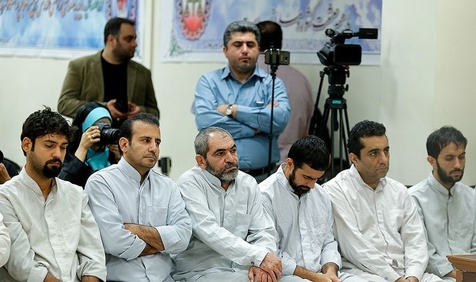 Since the 1979 revolution, Azadi Square has been the beating heart for major demonstrations in Iran’s capital. So when the Iranian judiciary announced on September 24 that “financial corruptors” would be hung in the square—a first—it was seen as a dire warning to corrupt traders and government officials that they would be made an example of for the rest of the country.
Since the 1979 revolution, Azadi Square has been the beating heart for major demonstrations in Iran’s capital. So when the Iranian judiciary announced on September 24 that “financial corruptors” would be hung in the square—a first—it was seen as a dire warning to corrupt traders and government officials that they would be made an example of for the rest of the country.
Weeks later on October 1, three men were sentenced to death for financial corruption. They included a gold dealer nicknamed the “sultan of coins” by Iranian media for collecting two tons worth of gold coins and selling them at inflated rates. The men are currently appealing the sentences. Then on October 6, Interpol extradited to Tehran an Iranian businessman who fled after defrauding thousands of investors out of hundreds of millions of dollars after they purchased gold coins on a website.
During the past year, Iranian officials have often blamed “outside enemies” for the country’s economic woes. However, even before US President Donald Trump’s announcement that he was withdrawing from the Joint Comprehensive Plan of Action (JCPOA), Iran’s currency, the rial, started to crumble. Since April, the rial has lost 70 percent of its value compared to the US dollar as Iranians have sought to safeguard their savings by converting it into foreign currency and gold coins.
It has taken nine months since the December 2017 nationwide demonstrations—over the state of the economy, corruption, and general disenchantment with the Iranian establishment—for protesters to garner the full attention of the upper echelons of the Iranian government. Now Iranian officials appear to be feeling the pressure from sporadic ongoing protests, scandals about cell phone importers taking advantage of foreign currency privileges, and the hoarding of gold coins and hard currency—not to mention the re-imposition of US sanctions.
The judiciary, a technically independent body whose head, Ayatollah Sadeq Larijani, was appointed by Supreme Leader Ayatollah Ali Khamenei, is currently leading the fight against corruption. This is ironic since Larijani was recently singled out by the Trump administration as having corruptly amassed $300 million in personal wealth.
In a letter to the Supreme Leader in August, Larijani referred to the current situation as an “economic war.” Khamenei gave the judiciary chief his blessing for this war by calling for “swift and just” action against violators. This has resulted in “special courts for economic crimes” being set up with maximum sentences for those “disrupting and corrupting the economy.”
The judiciary recently announced that it had arrested at least 120 people for manipulating the currency market and receiving perks on foreign-import licenses. Some trials have aired on state television, which isn’t a routine practice.
The Iranian government has also intervened in the currency markets by setting several official rates and opening a secondary exchange to stem the rial’s decline. President Hassan Rouhani has also reshuffled his cabinet to give the further impression that the government takes the crisis seriously.
These mechanisms and personnel changes have helped, to an extent. But there are limits to how much they can accomplish given Iran’s endemic mismanagement and corruption and the harsh impact of US sanctions.
Some Iranian officials appear to still be in denial about the extent of the crisis. Prosecutor General Mohammad Jafar Montazeri denied that there is systemic corruption in the country. Montazeri said on October 10, “It would mean that all managers from the top down to the bottom are corrupt, but we don’t have such a situation in the country and only some middle managers may have cases of corruption.”
Despite the emphasis on the crackdown on corruption, Rouhani’s chief of staff asked the editors of major newspapers to “help the government to solve problems and inject hope and vitality in society” since enemies have created “a difficult economic situation”—an indirect reference to US sanctions. The comments could be interpreted as keeping negative economic news out of the spotlight.
Similarly, Tehran prosecutor Abbas Jafari Dolatabadi told journalists to avoid sharing reports that would destabilize Iran’s market—in other words, the crumbling rial. Last week, Dolatabadi shut down seventeen websites that shared real-time exchange rates based on local observations. Iran’s cyber police discovered 1,381 websites that “created tension in the gold coin market” and over 500 websites were blocked, while 200 are under investigation, according to the prosecutor. The remaining websites are reportedly managed outside Iran.
These public displays of tackling profiteering and corruption are only a Band Aid, however. Even entertaining the possibility of hanging miscreants in a prominent square won’t resolve Iran’s endemic problems. The Iranian government needs to make major economic reforms which go beyond prosecuting a few corrupt individuals.
Khamenei suggested on October 12 that economic problems should be separated between those caused by sanctions and those tied to internal and structural issues. Such a close examination is a start for finding solutions, but would also mean reassessing the economic role of the powerful Islamic Revolutionary Guard Corps and semi-governmental organizations such as bonyads or charitable foundations. Is the Iranian government ready to take on such heavyweights? So far, that appears unlikely.
Holly Dagres is editor of the Atlantic Council’s IranSource blog, and a nonresident fellow with the Middle East Security Initiative in the Scowcroft Center for Strategy and Security. She also curates The Iranist newsletter. Follow her on Twitter: @hdagres.
Image: Iranian traders at their corruption trial on October 1 (jamaran.ir)
